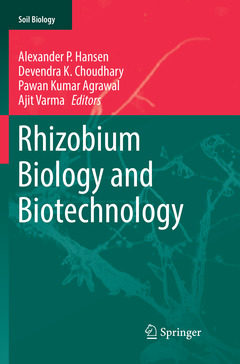Description
Rhizobium Biology and Biotechnology, 1st ed. 2017
Soil Biology Series, Vol. 50
Coordinators: Hansen Alexander P., Choudhary Devendra K., Agrawal Pawan Kumar, Varma Ajit
Language: English
Subjects for Rhizobium Biology and Biotechnology:
Publication date: 08-2018
Support: Print on demand
Publication date: 10-2017
Support: Print on demand
Description
/li>Contents
/li>Comment
/li>
This book provides in-depth reviews of the role of Rhizobium in agriculture and its biotechnological applications. Individual chapters explore topics such as: the occurrence and distribution of Rhizobium; phenotypic and molecular characteristics of Rhizobium; impact of Rhizobium on other microbial communities in the rhizosphere; N2-fixation ability of Rhizobium; Rhizobium and biotic stress; Rhizobium-mediated restoration of an ecosystem; in silico analysis of the rhizobia pool; further biotechnological perspectives of Rhizobium.
Molecular genetic dissection of nodule formation and regulation in legumes.- Redox state and antioxidant defense in rhizobia: Effects in legume symbiosis.- Impact of Rhizobium on rhizospheric microbial communities.- Tracking milestone advances in exploiting Rhizobium in biocontrol of plant diseases.- Persistence and survival of Rhizobium in soil.- Restoration of degraded pasture soils on the basis of EM Associations.- Rhizobium as a crop enhancer and biofertilizer for increased non-legume production.- Role of root-nodule bacteria in improving soil fertility and growth attributes of leguminous plants under arid and semi arid environments.- Diversity, nitrogen fixation and biotechnology of rhizobia from arid zone plants.- Bradyrhizobia Mediated Drought Tolerance in Soybean and Mechanisms Involved.- Rhizobium in Rice Yield and Growth Enhancement.- Control strategy of plant parasitic nematodes by Rhizobium in agricultural crops.- Plant growth promoting Rhizobium (PGPR): mechanisms and biotechnological prospectives.- Identification and molecular characterization of rhizobia nodulating legumes.- Genetic Construction of Stable Rhizobial Genotypes for Improved Symbiotic Nitrogen Fixation.- Hierarchical Clustering based Algorithms and other in silico Techniques for Phylogenetic Analysis of Rhizobia .- Species diversity of Rhizobia.- Biotechnological perspectives of plant-Rhizobium symbiosis.- Exopolysaccharide production in Rhizobia : Biotechnological Implications.- Cryopreservation of rhizobial strains.




